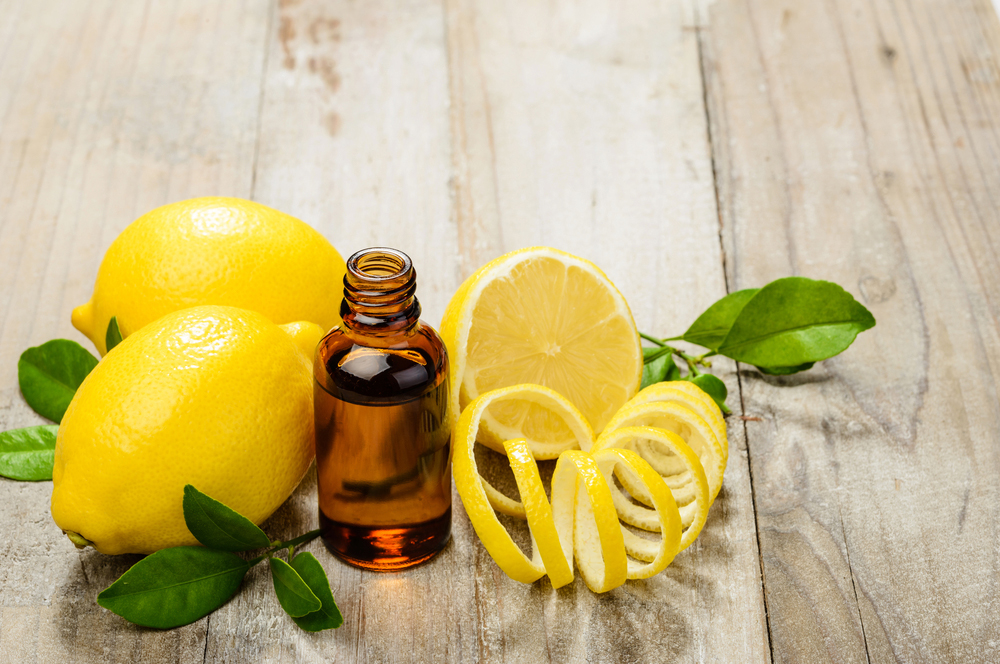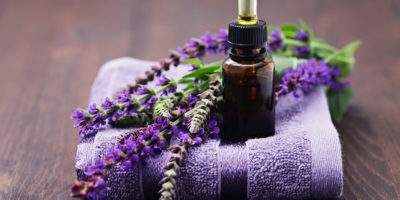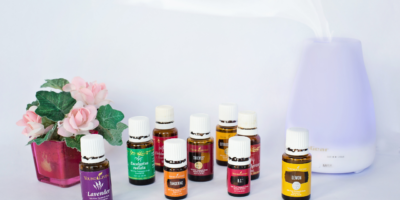Essential oils are versatile — each one can perform a variety of functions. There are 10 essential oils in the Basic Care Kit, which between them will manage a huge number of problems. The short profile of each of these oils that follows may help you decide which to include in your kit, and which to add as time goes on. The choice will very much depend on your own requirements.


1. LAVENDER


Lavender is an indispensable essential oil — it’s not only useful to have at home but many people won’t leave home without it. In a sense, it’s the mother of all essential oils: incredibly versatile, yet powerful. The aroma doesn’t suit all tastes, but when someone suffers a minor burn or scald, a cut or graze, an insect bite or a headache, a tooth abscess or sleeplessness, it’s lavender they call for.
Not only is lavender a spectacular healer that also prevents scarring, but it’s also a mood tonic that brings calm, relaxation, and stress relief. Lavender oil is a natural antiseptic, antibiotic, and slightly antifungal agent that’s also a sedative and antidepressant. Although not known specifically as a circulatory stimulant, lavender oil certainly seems to allay the effects of clinical shock. Lavender is one of the few essential oils that could be applied undiluted to the skin in certain acute conditions.
2. GERANIUM


Geranium is deceptively charming. If the quality is good, the aroma of geranium essential oil is clean and floral and enjoyed by almost everyone, including children and teenagers. The sweet aroma of geranium masks the fact that this is an antiseptic and antibacterial oil, making it a good choice to include in antiinfective blends, while also being an analgesic. Geranium is indispensable in the treatment of circulatory and blood disorders; it will help chilblains to disappear and help alleviate the effects of frostbite. Geranium brings hormonal balance and is a vital component in addressing female reproductive conditions, including menstrual and menopausal problems and infertility.
Geranium oil is excellent in body care and brings a radiant glow when used in skincare. Its astringent properties contribute to its general usefulness. It also works profoundly on emotions, serving as a nerve tonic and as a sedative. It’s fantastic in blends because just one drop used as a back note will mask a healing aroma that might otherwise be too medicinal. Aromatically, geranium is an equalizer, making everything smell a bit better, and as such, it is a great allrounder in room fragrances.
3. THYME LINALOL


There are several types of Thymus vulgaris essential oil available, but the chemotype (ct.) linalool is preferred because it’s versatile, has a long history of use in clinical aromatherapy and is more compatible with skin applications because it’s considered non-irritating.
Thyme linalol is like a valued warrior, having powerful antiseptic, antiviral, antibacterial, and antifungal properties. Few oils are as useful as thyme linalol when there’s an internal infection of some sort, or when “flu” or other contagious conditions are a threat. Even one or two drops of thyme linalol used in a room diffuser mix of, for example, geranium, lemon, and cardamom will add purifying anti-infectious protection.
The antimicrobial aspects of thyme linalol are enhanced by other properties attributed to this oil, such as its immune stimulant and diuretic properties. Thyme linalol is excellent in the treatment of soft tissue and joint conditions, including rheumatism. It’s also used in cases of neuralgia and fatigue and in hair-and skin-care regimes, including those for acne. In addition, thyme linalol isa good brain stimulant, boosting the capacity for analytical thought.
4. CHAMOMILE ROMAN


There are several essential oil-producing plants called chamomile, but the two most commonly used in aromatherapy and known as the true chamomiles are chamomile roman, which is included here, and chamomile german (Matricaria recutita), which is distinguished by its beautiful deep-blue color, due to a high azulene content.
Chamomile Roman is an excellent anti-inflammatory oil, which makes it valuable in a wide range of conditions. It is also antiseptic, antibacterial, and when combined with other oils, analgesic, and it is used in recovery from burns, including sunburn, as well as for asthma, sprains, strains, diarrhea, nausea, and fever. It is also used for a variety of skincare issues, including in rejuvenation treatments. Chamomile Roman is calming and sedative — particularly effective in the treatment of nervous conditions, depressive states, and insomnia. It has a balancing effect in blends.
Chamomile is a strong but humble oil that works on the mind, body, and spirit, the psychological as well as the physical. As it’s essentially a soothing oil, chamomile roman is good to use with children, and also with the inner child in adults. This is an oil with many subtle levels.
5. ROSEMARY


Rosemary is a good analgesic essential oil, useful in the treatment of all muscular problems, as well as joint conditions such as arthritis and rheumatism. It’s used both for respiratory tract issues and, in small amounts, for conditions of the liver and kidneys. Rosemary is a very stimulating essential oil, having an effect on both the physical body and the analytical mind. All these attributes make rosemary energizing when facing an exhausting, mentally challenging day, or following a physically stressful one.
Rosemary is an aid to memory — whether required for enhancing the ability of the brain to function well or exploring long-term emotional memory. It’s also used in the treatment of depression, migraines, headaches, anxiety, and stress. Rosemary is helpful in a variety of beauty treatments, including those for cellulite, acne, and hair care. For the sportsperson, cook, or gardener, rosemary is invaluable.
6. PEPPERMINT


Peppermint is hugely helpful in all problems of the digestive tract, including indigestion, flatulence, irritable bowel syndrome, and stomach-derived halitosis. It’s also useful in certain conditions of the respiratory and circulatory systems and as an all-around tonic. Peppermint is an analgesic, antiseptic, cooling, antiinflammatory oil with some antifungal properties. It has a place in the treatment of catarrh, headaches, migraines, skin irritations, rheumatism, toothache, and fatigue. In small amounts, it can be incorporated into complex perfumes or room blends, providing a subtle back note. It has a unique place in cookery, while also being able to keep ants, fleas, and mice away. Peppermint is a multipurpose oil, and useful addition to the Basic Care Kit.
7. CARDAMOM


Cardamom has layers of healing ability, starting with its calming effect on the digestive system, making it a good choice when dealing with flatulence, stomach or abdominal cramps, irritable bowel syndrome, or Crohn’s disease. Cardamom is antibacterial and antifungal, as well as analgesic and anti-inflammatory. It helps ease muscle cramps and spasms and, as an adaptogen, has a calming yet stimulating effect. Cardamom can also be used for most types of coughs and is useful for respiratory problems, as well as for certain types of food-related infections.
As if all this were not enough, cardamom can be used in cases of exhaustion — whether physical, mental, or emotional. It’s stimulating in cases of tiredness or fatigue, yet has a calming effect on the mind and nerves during times of stress. Cardamom has a balancing and harmonizing effect on the body and mind. It’s also a gentle ingredient in skin preparations and can be used in cooking.
8. LEMON


The lemon essential oil has a tonic action on the lymphatic system and a stimulating action on the digestive system. It can be used to alleviate bilious attacks, and when combined with other essential oils, it can contribute to the treatment of verrucas, insect bites, and tension headaches. Lemon can assist metabolic function and is useful in skincare. Although slightly sedative and calming, lemon essential oil greatly aids focus and concentration, especially when part of a blend. The fresh, clean aroma of lemon is universally liked, making it highly useful as a synergistic addition to room fragrances and perfuming blends. This antiseptic and uplifting essential oil has a place in household care and, of course, is invaluable as a flavoring agent. The lemon essential oil can be used for so many things — as a water purifier, in skincare, and body treatments — it is a true allrounder.
9. EUCALYPTUS RADIATA


Eucalyptus Radiata has been chosen for the Basic Care Kit because it’s the species of the genus Eucalyptus that can safely be used on those with long-term chronic conditions, while also being a strong and effective essential oil.
Eucalyptus Radiata is perhaps best known for its effectiveness against respiratory tract infections, but it has many other uses too. This is an antiseptic, antibiotic, antiviral, and analgesic essential oil, with anti-inflammatory, diuretic, and deodorizing properties. As part of complex blends, Eucalyptus Radiata can also be helpful in the treatment of cystitis and candida. It cools the body in summer, while also treating sunburn and deterring insects, and it is warming in the winter while keeping infection at bay.
10. TEA TREE


Tea tree essential oil is antiseptic, antibiotic, antiviral, and antifungal — making it useful for a wide range of conditions. It’s used in the treatment of various infections, including candida, ringworm, and athlete’s foot, as well as for toothache, sunburn, cuts and grazes, and various skin conditions, including acne. It could also be incorporated into mouthwashes and hair shampoos. Tea tree oil is widely used as an insect repellent and to treat insect stings. Although the aroma is not to everyone’s taste, it can easily be disguised with other essential oils for use in room diffusion methods when someone in the household has a contagious airborne infection.






Leave a Reply